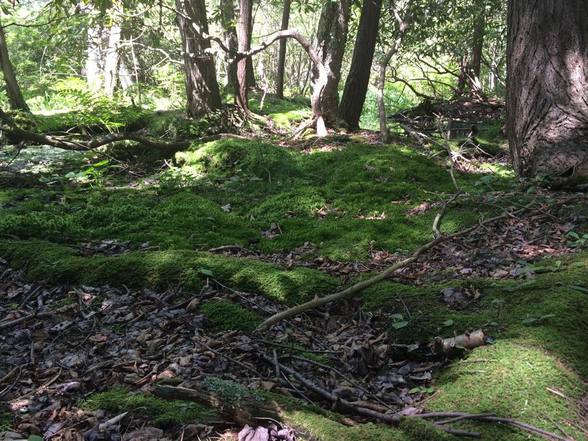A bog is an area of naturally waterlogged ground too soft to support a heavy body. The bottom of a bog is usually covered in layers of dead and decaying plant material. Lacawac's 7.1 acre bog here is a result of past glaciation which formed Lake Lacawac and resulted in the accumulation of peat moss and other organic sediment. This provided a substrate for plant growth once the glacier receded.
What is a bog?
A bog is a wetland that accumulates peat, a deposit of dead plant material—often mosses, and in a majority of cases, sphagnum moss.] It is one of the four main types of wetlands. Other names for bogs include mire, quagmire, and muskeg; alkaline mires are called fens. They are frequently covered in ericaceous shrubs rooted in the sphagnum moss and peat. The gradual accumulation of decayed plant material in a bog functions as a carbon sink.
Bogs occur where the water at the ground surface is acidic and low in nutrients. In some cases, the water is derived entirely from precipitation, in which case they are termed ombrotrophic (rain-fed). Water flowing out of bogs has a characteristic brown colour, which comes from dissolved peat tannins. In general, the low fertility and cool climate results in relatively slow plant growth, but decay is even slower owing to the saturated soil. Hence peat accumulates. Large areas of landscape can be covered many metres deep in peat.
Bogs have distinctive assemblages of animal, fungal and plant species, and are of high importance for biodiversity, particularly in landscapes that are otherwise settled and farmed.
Bogs occur where the water at the ground surface is acidic and low in nutrients. In some cases, the water is derived entirely from precipitation, in which case they are termed ombrotrophic (rain-fed). Water flowing out of bogs has a characteristic brown colour, which comes from dissolved peat tannins. In general, the low fertility and cool climate results in relatively slow plant growth, but decay is even slower owing to the saturated soil. Hence peat accumulates. Large areas of landscape can be covered many metres deep in peat.
Bogs have distinctive assemblages of animal, fungal and plant species, and are of high importance for biodiversity, particularly in landscapes that are otherwise settled and farmed.
Habitats
There are many highly specialised animals, fungi and plants associated with bog habitat. Most are capable of tolerating the combination of low nutrient levels and waterlogging. ]Sphagnum moss is generally abundant, along with ericaceous shrubs. The shrubs are often evergreen, which is understood to assist in conservation of nutrients.[8] In drier locations, evergreen trees can occur, in which case the bog blends into the surrounding expanses of boreal evergreen forest.[9] Sedges are one of the more common herbaceous species. Carnivorous plants such as sundews (Drosera) and pitcher plants (for example Sarracenia purpurea) have adapted to the low-nutrient conditions by using invertebrates as a nutrient source. Orchids have adapted to these conditions through the use of mycorrhizal fungi to extract nutrients.[10] Some shrubs such as Myrica gale (bog myrtle) have root nodules in which nitrogen fixation occurs, thereby providing another supplemental source of nitrogen.[11]
Bogs are recognized as a significant/specific habitat type by a number of governmental and conservation agencies. They can provide habitat for mammals, such as beavers.
Bogs are recognized as a significant/specific habitat type by a number of governmental and conservation agencies. They can provide habitat for mammals, such as beavers.
Location |
|
